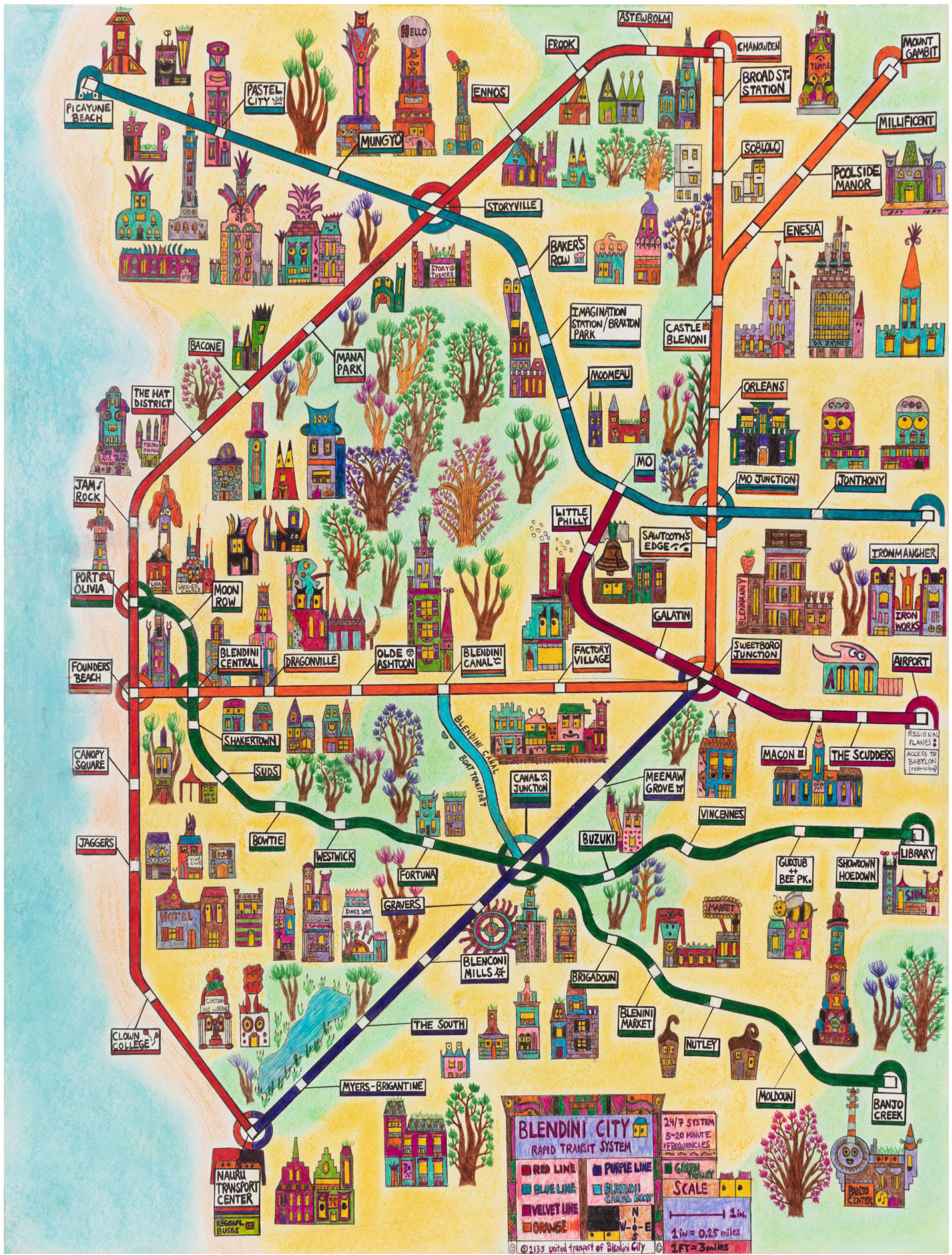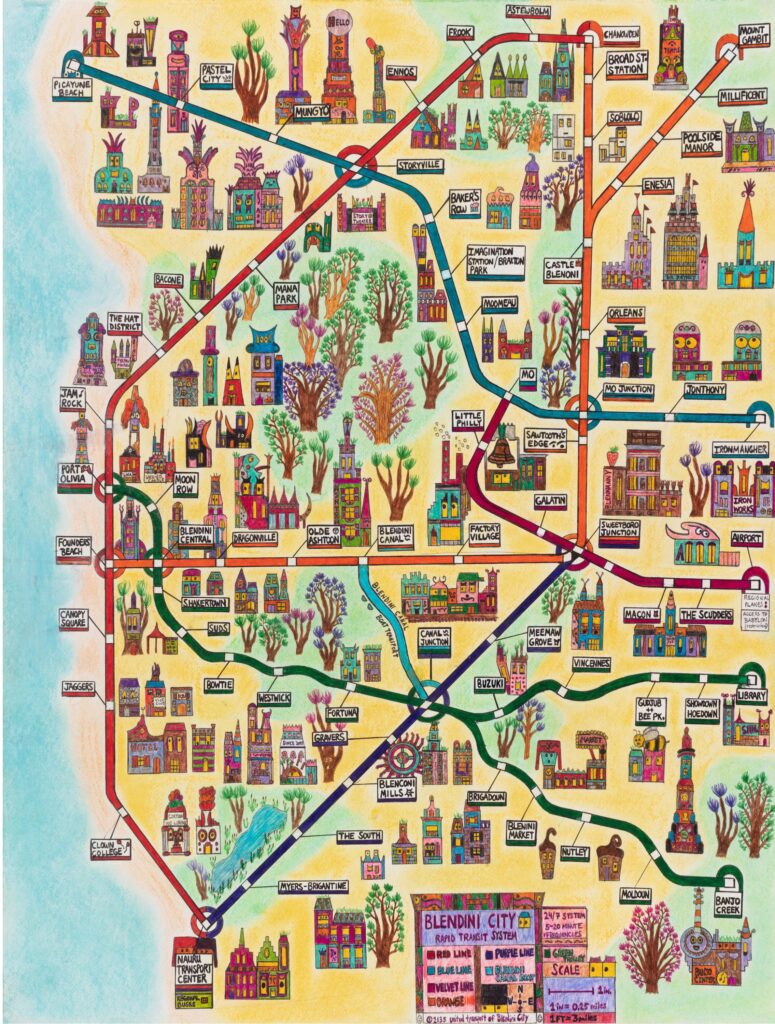Should the Blendini City Metro Rail system expand?

The Pros & Cons of Expanding Blendini Metro Rail
During my time creating and being the Mayor of Blendini City, I’ve seen the Blendini Metro Rail system go from an idea on a napkin to a full-scale and city-wide mobility engine. Our transit system is also supplemented by the bus, trolleybus network, and highways for human-powered vehicles. I’m not including personal automobiles in this analysis as that system is set in place with no kinds of expansions in the works. In addition, a flourishing private transit network exists to fill in the gaps. The current system you see here was completed in 2135 and it’s now been 15 years since the last Metro Rail expansion.
Mobility in the city overall is quite good, but some obstacles continue to make mobility not as efficient as it could be.
The question is, should we expand the Blendini Metro Rail system? My position as the Mayor is, “Definitely yes, but…” The devil is always in the details. I think we all agree that more mobility is good, but where and how is always the question of the day. And the bigger point is, does the Metro Rail system need to expand or something else? As I said, I support “more Metro Rail”, but I need to look at the whole issue from a 360-degree perspective, as it is my personal responsibility to do so as the Mayor, and the goal is more mobility, not necessarily “more rail.”
Before I go into the Pros and Cons, here is the Metro Rail map again for your reference:

The case for expanding the Blendini City Metro Rail
Blendini City has multiple population centers, as it is a polycentric city. The transit system reflects this, so it’s not as revolved around downtown. I do think that the Metro Rail can better address getting downtown, though.
Some neighborhoods are less efficient to get to at the moment. For example, the Blendini Central to Pastel City connection is not the best and these are two population centers. The connection currently requires taking the Green Rail to Port Olivia, then going on the Red Rail up to Storyville, and then transferring to the Blue Rail back towards Pastel City.
There is a bus that connects the Hat District Red Rail stop and Pastel City, but it’s beyond capacity because, once again, these are two population centers and you are dumping a lot of people from a fast, high-capacity mode to a slower, low-capacity one. A spur line from The Hat District to Pastel City, I think, would be a good project that would be a good bang for the buck.
But the bigger challenge is addressing what I think is the greatest gap in the network, which is getting between the Blendini Canal and points north. I’m personally against the proposed solutions, but I’m too big of a proponent of preserving the Central Woodlands. We could do a deep bore tunnel to create a connection, but that would be enormously expensive.
My idea to address the bigger challenge is to increase the capacity and speed of the existing lines so that it’s more efficient to get around the Woodlands. This would mean building extra tracks on existing lines, creating express lines, and “interlining” as to decrease the need for transfers. For example, I’d love to see a more direct connection between Blendini City International Airport and Blendini Central.
So at the end of the day, my plan (some disagree with me and are more bullish on expansion, believing we should slice and dice the Central Woodlands) would be to optimize what we already have and add short spur routes to thread the connections better.
Those connections would include:
- Rail from The Hat District to Pastel City
- Express tracks, more cross-platform transfers, and interlining (with more tracks)
- Direct rail from Mo to Castle Blenoni
- Adding a loop line for Blendini Central-Port Olivia-Moon Row-Founders’ Beach. Think of it like Chicago’s Loop, where the Green Rail, Red Rail, and Orange Rail would all enter the loop and offer that service so that transfers aren’t required to get to multiple “central destinations”
- Pie-in-the-sky idea: Creating an outer loop for the rail system, connecting Nauru TC, Blenini Market, Library, the Airport, Ironmangher, and Poolside Manor.
The case for not expanding the Blendini City Metro Rail
We need to start by saying that there will be geographical obstacles that need to be overcome for any of this to happen. The Central Woodlands is a forested, hilly, natural paradise in the center of the city that acts as “the lungs of Blendini City”. Wildlife roams in certain parts and there is a whole natural ecosystem there that is fragile.
There is a litany of unintended consequences that would occur by building any kind of rail through the Central Woodlands and the costs involved. Right now the human-powered vehicle trails are the way to get through as well as the walking paths. While rail expansion doesn’t have the same monstrous environmental issues as auto-centric ones do, we are fooling ourselves if we don’t acknowledge the issues. The ends have to justify the means, but the means also have to justify the ends.
This city has an environmentally sensitive history. We also are a fiscally compassionate and daring city, but we also don’t throw money at things. Every dollar spent is for the good of the city, and sometimes big-ticket transit projects are not what is most needed. It’s good that we have built the network as we have done, but population patterns change, and I think there has been a benefit to the wait-and-see approach of the last 15 years. It’s also been good from a maintenance-perspective. Expansions are exciting, but not at the expense of what we already have. For some years, it’s been a struggle to fund the existing infrastructure.
As I wrote before, I’m “pro-rail” and when it comes to voting in the next election for more Metro Rail funding, I strongly suggest yes. But I also want to show you that I’m not blind in my thinking and I’m not “pro-rail” for the sake of it.
So if we don’t expand Blendini Metro Rail, here’s what I suggest we do:
- Increase bus frequency, signal prioritization, and busways
- Similar to my pro-rail list, I think we need cross-platform transfers. And if any project needs to get funding, it’s creating the Downtown Loop, because that will have a huge knock-on effect for the entire city.
